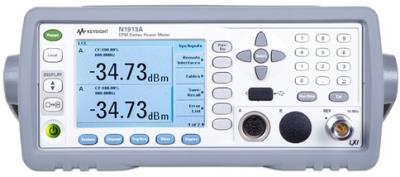
|
|
The Keysight N1913A EPM Single-channel average power meter you get these features. Get up to four channels (Additional two optional USB channels available) to speed and simplify RF average power measurements. Measure faster with improved measurement speed of 400 readings/sec with the Keysight E-Series sensors. View test results more easily with the industry’s first color LCD readout in an average power meter. Go beyond GPIB with USB and LAN/LXI-C interfaces. Automate frequency/power sweep measurements with the optional external trigger in/out feature. Confirm battery power with a single-button push (models with battery option)-and get extra operating time with the optional spare battery. Easily replace existing 436A, 437B meters with optional 436/437 code compatibility. Enhance manufacturing test by connecting a large external monitor with the unique VGA output option.
Specifications.
Frequency range: 9 kHz to 110 GHz.
Power range: -70 dBm to +44 dBm (100 pW to 25 W, depending on the attached power sensor).
Measurement speed: Up to 400 readings/sec with E-Series sensors.
Absolute accuracy: ±0.02 dB logarithmic, ±0.5% linear.
Relative accuracy: ±0.04 dB logarithmic, ±1% linear.
Display resolution Selectable resolution of: 1.0, 0.1, 0.01 and 0.001 dB in logarithmic mode, or 1, 2, 3 and 4 significant digits in linear mode.
Absolute accuracy: ±0.02 dB (Logarithmic) or ±0.5% (Linear).
Effects of averaging on noise: Averaging over 1 to 1024 readings is available for reducing noise.
Options.
Opt 102: Single/dual-channel average power meter, battery.
Opt 103: Single/dual-channel average power meter, battery, two rear USB ports.
Opt 104: Single/dual-channel average power meter, VGA.
Opt 105: Single/dual-channel average power meter, battery, one front and one rear USB port, VGA.
Opt 106: Single/dual-channel average power meter, one front and one rear USB port.
Opt 107: Single/dual-channel average power meter, external trigger IN/OUT.
Opt 108: Parallel rear panel sensor input connectors and front panel reference calibrator connector, two rear USB ports.
Opt 109: Parallel rear panel sensor input connectors and rear panel reference calibrator connector, two rear USB ports.
Opt 200: 436A and 437B code compatibility.
|